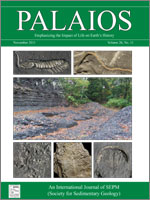More than two hundred subcircular to crescent-shaped depressions, often with radiating markings, were discovered on a 120 m2 bedding plane interpreted as base-of-slope carbonate deposits and belonging to the Lutetian–Bartonian Peschici Formation at San Lorenzo (Vieste, Gargano Promontory, Italy). The area was mapped using a high-resolution aerial camera (mounted on a kite) and a terrestrial laser scanner. The survey allowed detailed morphologic analysis and topographic mapping of the traces, in order to analyze the very regular distribution pattern. The ichnological study, combined with sedimentologic and stratigraphic analyses, identifies the depressions as fish feeding traces. Although the tracemaker cannot be definitely identified, the comparison with modern and fossil fish excavations suggests a higher affinity with bony fishes (e.g., sturgeons) than with rays. The trace fossils are here attributed to the ichnogenus Piscichnus and constitute the first discovery of this ichnotaxon in the middle Eocene of the Apulia Carbonate Platform and of Italy.
How to translate text using browser tools
1 November 2011
FISH FEEDING TRACES FROM MIDDLE EOCENE LIMESTONES (GARGANO PROMONTORY, APULIA, SOUTHERN ITALY)
MATTEO BELVEDERE,
MARCO FRANCESCHI,
MICHELE MORSILLI,
PIETRO LUIGI ZOCCARATO,
PAOLO MIETTO
ACCESS THE FULL ARTICLE
It is not available for individual sale.
This article is only available to subscribers.
It is not available for individual sale.
It is not available for individual sale.

PALAIOS
Vol. 26 • No. 11
November 2011
Vol. 26 • No. 11
November 2011




